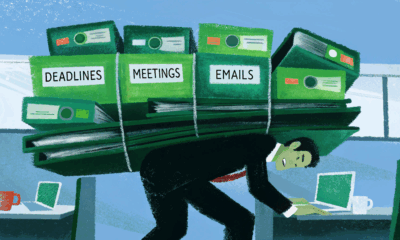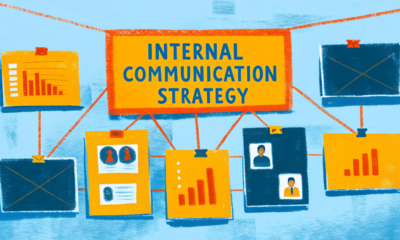Collaboration
6 Tips on Running a Successful One on One Meeting

There is no doubt that effective communication is the backbone of any successful organization. For effective delivery, you must ensure that your employees have a smooth and effective way of communicating with each other. That will help allow your company to work efficiently and provide quality service to your customers.
Although there are many ways employees can communicate internally, organizing a one on one meeting is a great way to collaborate. It’s no secret that the COVID-19 has changed business communication. That has made virtual face-to-face meetings important as never before. Now we have video conferencing software programs that make virtual one on ones hassle-free.
However, it’s important to ensure that the technology used for virtual meetings is reliable and accessible for all team members. This ensures that communication flows seamlessly without unnecessary disruptions or technical issues.
Furthermore, 1 on 1 meeting can also be held with face-to-face interactions. Shortly, I will be walking through how to run a successful one on one meeting. Before I get started, what are the benefits of the face-to-face meeting?
- Sometimes an honest feedback is more proactive than an expert’s opinion on how to make your company mentally healthy. A one on one meeting is a perfect way to get genuine feedback from your team members on company policies, working conditions, and observations on sales and customers.
- Effective in team-building with your employees.
- It ensures a friendly and healthy working environment.
- It is the perfect avenue for exploring some of the best employee engagement ideas.
- You get pointers on what you should work on in your business.
- When you host a successful face-to-face meeting, it has a positive impact on your sales funnel.
Now that is out of the way. Let us get down to everything you need to do to have a successful one on one meeting.
Be prepared
The success of one on one has a lot to do with your prep work before the meeting. Often, the prep work cuts across scheduling, deciding on discussed topics, planning, and setting goals and objectives.
First off, one way to ensure success is to remind your team members about the face-to-face meeting. A reminder can be sent in email or text messages and can be followed as three months, four weeks, Seven days, and 24 hours before the D–day.
Make sure you allow time for any last-minute changes or scheduling conflicts that may arise, as this will keep you flexible and ready to adjust. This way, everyone stays on track for the meeting.
It is advisable to go through your note to see if everything checks a few hours into the meeting. If this is your first face-to-face meeting, it is normal to feel nervous. Take a deep breath and remind yourself that preparation is key to confidence. As long as you follow the steps in this guide, you’ll be just fine.
Lastly, check your tech setup before the meeting, especially if it’s virtual. Ensuring your video and audio are working smoothly will prevent distractions or delays during the meeting.
Keep an open mind
If every conversation during the meeting is about work, the one on one tends to get awkward and tense real-quick. But a little humor and casual discussion will prompt the other party to relax and speak freely. Remember, the goal here is to get honest feedback.
Let your body language reflect openness. A warm smile or a nod can signal that you’re engaged and approachable.
Ask the Right Question
It is pretty easy to go off the rails in a face-to-face interaction. Earlier, I stressed the need to keep a friendly conversation. But there is a thin line between being too professional and making your employee feel uncomfortable. That is why I have pinpointed some relevant questions for your 1 on 1 meeting. With these questions, you will have an interesting conversation. It will also help you accomplish set goals and objectives.
- Personal check-in questions: Commence a one on one meeting with check-in questions. These questions will help you evaluate their state of mind, and understand what’s up with your team members (without getting too personal). Try not to be invasive with these check-in questions.
- How are you doing?
- How’s it going today?
- In our last session, you said you were having some difficulties with (state the challenges), how’s it working out now?
- Work-related questions: These questions center on a company’s confidence, engagement survey, or even big changes in an organization. It will help you figure out how connected your employees feel to your company. Other than that, you get to know about their progress in the company.
They include:- Do you have any observations regarding the recent changes (mention any recent development in your company like a product launch and new company policies)?
- How confident do you feel with the company’s vision?
- How aligned do you feel with where the company’s heading?
- Where do you think the company will be in the next 3 to 5 years?
- Over (years/months) you have been with the company, what has challenged you?
- What inspires you the most since you’ve been with us?
- Team building questions: It’s no secret that individuality and disunity make a workplace a living hell. Before a team can thrive, there has to be some level of bonding and getting along. These interpersonal questions will help put your house in order.
- How will you describe your relationship with your co-workers?
- Are there any interactions you would like to discuss?
- Do you have any feedback for me?
Pay Rapt Attention
A one on one meeting should be a safe space where your team members can be expressive. As they provide answers to each of these questions, it is paramount to pay rapt attention to them.
Do not cut them short when they are talking. Instead, take time to listen to their contribution and try to acknowledge their suggestions. A report by Doodle’s State of Meetings Report 2019, outlines some of the major factors that can leave meeting attendees irritated and unsatisfied. This report ranks interrupting others (50%) and failure to listen to others (49%).
If it is a virtual meeting, ensure that you are in a serene environment. Check out this resource on how to run a successful virtual meeting.
Places like the office garden, lobby, and coffee shop are perfect for one on one meeting.
If there is a need to ask questions, ensure that you ask politely and in a friendly manner.
Take Note
Taking notes is not a waste of time. It helps you keep a record of the things you need to work on in your company. Chances are, you will have one on one meetings with your entire team. Take note of pointers from every team member. It is not advisable to make use of your computers to take note, this is because you can be easily distracted by notifications which will likely disrupt the flow of the interaction with your team member.
Try using a simple pen and paper or note-taking app that minimizes distractions, so you stay focused and present during the discussion.
Apart from taking note, you can also record your screen with screencasting software programs for virtual face-to-face meeting.
End on a Good Note
Ensure to end one on one meetings on a good note and make sure your colleague is engaged at the end of the meeting. A report by Gallup shows that in 2020, only 36% of employees are engaged in their workplace, leaving 64% of employees unengaged.
Today, a lot of workplaces still don’t get it right with employee engagement. Your team members should feel motivated and refreshed after a meeting, not the other way round. An ideal one on one meeting should aim at bridging the gap between management and their employees. You can put yourself on a spot by seeking their opinion and advice on your management skills.
Furthermore, everything should not just be about you and the company. Give genuine compliments. Let them know you appreciate their effort and contribution towards the development of your company.
Lastly, express gratitude for their time and contributions during the meeting. It sets a positive tone for the future and motivates employees to continue to share their insights.
Post-meeting follow-up
Just because the meeting is over doesn’t mean the conversation should stop. The real work begins after the meeting when you put everything discussed into action. Here’s how to ensure that the feedback you received doesn’t get lost in the shuffle:
- Summarize key takeaways
After the meeting, take a moment to summarize the key points discussed, especially any action items or important feedback. A quick follow-up email or message to your team member helps both of you remember the next steps and ensures everyone is on the same page. - Set clear action plans
Turn the feedback into actionable goals. Whether it’s addressing a challenge they raised or implementing a new idea, make sure that you both leave the meeting with clear, measurable goals. This sets expectations and ensures that there’s progress to discuss next time. - Check-in regularly
One-on-one meetings should be a part of an ongoing conversation. Schedule follow-up check-ins to track progress on the action items you discussed. Regular touchpoints ensure that any issues get addressed quickly, and you can celebrate wins along the way. - Create a feedback loop
Keep the lines of communication open by showing that you’re acting on their feedback. Whether it’s improving a process, adjusting a policy, or implementing a suggestion, let your team members know that their input matters. This helps maintain trust and encourages continued openness in future meetings.
By ensuring that your one-on-one meetings lead to tangible actions and improvements, you’re creating an environment where feedback is truly valued, and where both you and your team continue to grow together.
Conclusion
Everything that has been said here from getting ready to ending a one on one meeting on a good note will ensure that you have a great outcome. However, improving interpersonal relationships and intrapersonal communication will ensure there is a boost in your level of productivity. How is that? When your employee engagement is top-notch, and you have a healthy work environment, your team members are happy. And when they are happy, there is an increase in the level of your output.
Collaboration
4 Common Problems of Virtual Teams are Solved

Low-stress level, no commute, no shoes, PJs only, spending more time with family and friends, and so much more. Sounds neat right? According to some studies, remote work has brought higher productivity and a more positive work-life balance since the beginning of the pandemic. However, it’s not all rainbows and butterflies, is it? We have been facing some challenges, to say the least. We struggle with unplugging ourselves once the work is done for the day, we need our office gossip, and even though we don’t need to wear shoes, we still kinda miss them. Many problems can appear when we are managing virtual teams. However, does that mean we cannot ace a video meeting or have the same level of communication with our teammates as we did before? Never! All we have to do is get our hands to the right collaboration tools to manage our virtual teams. I give to you the solutions to the most common problems we’ve faced working from home. Trust me, it really is as easy as pie!
1. Communication breakdown: it’s not all about messages — it’s about meaning
The one most reported problem of remote teams is communication — or the lack of it. But it has nothing to do with missed messages. It has everything to do with lost context.
When you communicate face-to-face, 70–90% of what you intend is communicated through body language, tone of voice, and facial expressions. Remote workers lack that level. An urgent message meant to be productive will be cold. A wait in responding will be perceived as not caring.
That’s why business communications tools like Chanty, Google Chat, and GoToMeeting aren’t nice-to-haves, they’re must-haves. They facilitate teams to communicate in real-time, clarify their communication, and utilize richer media like voice and video. Still, the best tool is nothing without a shared communication culture.
HR comes into play here. Get teams to figure out how they communicate: messaging vs. meeting, how they handle urgency, and what “offline” means. Prioritize making voice notes and camera-on calls the new normal to bring back that human feel.
Communication isn’t only about words. It’s about being heard — and feeling connected.
2. Collaboration without clarity: the hidden cost of scattered work
In an office, things naturally tend to overlap. You stretch over a desk. You cut off someone at the coffee machine. You interpret a face at a brainstorming session.
In virtual teams, it doesn’t happen. And without the proper tools, folks will naturally feel like they’re working in solitude — despite being part of a team.
This is where Google Workspace, Microsoft 365, Dropbox, and OneDrive come in. These apps are not simply storage devices — they create a virtual workspace where collaborators can work together. Teams can work together on docs, comment in real-time, and have one source of truth.
But what really matters is psychological safety. If employees don’t feel free to give each other working drafts or ask for help, technology can’t fix that. HR leaders must create a space where collaboration means learning alongside one another, not just working alongside one another.
Technology reduces the friction. But humans reduce the fear. That’s how collaboration thrives.
3. Remote project confusion: why visibility matters more than ever
Without structure, remote projects can drift. Deadlines are missed. Jobs get blurry. Team members do not know what others are doing — or what they must do.
Project management tools like Asana, Jira, Basecamp, and SmartTask bring much-needed discipline. They break goals into doable pieces. They delegate tasks. They provide timelines and certainty.
But aside from task management, these sites are emotional clarity tools. When everyone can see who’s working on what, stress goes down. Nobody feels like they’re doing it all themselves. Nobody feels ignored. Transparency is peace of mind.
For HR, it’s a golden opportunity. Utilize these tools not just for productivity — but for inclusion. A reserved junior team member during meetings can spring to life when they are given clear guidance in a task board. A mute struggler might reveal to us their stress in overdue assignments.
Project management tools have secrets. Savvy HR teams listen intently.
4. Time and productivity tracking: from surveillance to self-awareness
Time tracking is one of the more controversial aspects of remote work. Done badly, it’s intrusive. Done well, it’s an amazing wellness and performance tool.
TimeDoctor, Hivedesk, Toggl, and PomoDone are some of the applications that enable teams to see how they spend their time. They show data on attention, idleness, and task-switching. To remote teams, this isn’t accountability — it’s awareness.
Most remote workers struggle to “switch off.” They work longer, take shorter breaks, and quietly burn out. HR can use time-tracking data not as a punisher, but as a protector. Recognizing overwork early is an act of care.
Furthermore, these tools empower people. People can look at when they’re most productive, or where they drift off course. They can set their own schedules, and build better habits.
The true value isn’t in tracking time — it’s in getting time to work more effectively for individuals.
Final Thought
No matter how many tools you bring on board, virtual teams will fail if their human needs are not met. The need to connect. To be seen. To understand. To trust.
Which makes HR’s role so critical. You’re not just choosing software —you’re developing culture. When you combine great tools with compassionate leadership, you don’t just solve issues — you create an environment where remote doesn’t equal removed.
Because in the end, remote teams don’t succeed because of technology.
They succeed because they care.
Collaboration
10 Pros and Cons of Working Remotely

Work-from-home arrangements are most successful when employers set clear parameters and invest in technology, such as videoconferencing, to help remote personnel feel like they are part of the team, – McDonald
Remote working, working-at-home, telecommuting, and any other similar variations of terms that describe working outside the walls of a traditional office, are getting increased popularity in recent years. Before Covid 19 working from home was a luxury that many of us dreamed of. Seeing pictures of remote workers in some distant places was something that we all wished for (at least I know I did). But let’s be real. Not all that glitters is gold. Working from home has some pitfalls as well.
There are many studies and statistics that favor both ways but together with my team, we decided to make a pros and cons list that will take you in and help you investigate this way of working, letting you weigh the advantages and disadvantages of the same.
The psychological and practical benefits of remote work
Let’s be honest — commuting five days a week to gaze at fluorescent lights while battling back-office gossip and surprise meetings isn’t necessarily a productivity dream. Remote work isn’t a trend — it’s a work life upgrade. And no, not because you can go to meetings in your pajamas (although we wouldn’t judge either).
This is what really makes remote work a game changer — for employees and HR teams.
1. You might actually get more done
Working remotely usually means fewer distractions. No watercooler conversation, no spontaneous 45-minute “quick syncs,” and none whatsoever heating fish in the break room.
- How it works: When you’re in charge of your surroundings, you focus more. It’s not anecdotal— psychologists call this lower cognitive load. Your brain isn’t spending energy repressing distractions.
- HR tip: Time to move beyond “Are they online?” to “Did the work get done well?” Focus on results. Trust trumps micromanagement.
2. Autonomy = Motivation
When people have control over how, when, and where they get their work done, magic happens. Self-Determination Theory (Deci & Ryan) is a reminder that autonomy is a strong psychological driver of motivation and engagement. In plain English? People want to be trusted adults.
- In the wild: Remote workers are more likely to feel happy to be responsible — not less. When employees take ownership, they’re apt to deliver.
- HR tip: Grant autonomy, but don’t lose sight of the map. Flexible policies work best alongside clearly set goals and accountability. Freedom thrives with structure — not chaos.
3. Work-life fit wins over work-life “balance”
“Balance” is such a misnomer, as if the work and life are two even weights on the scale. Come on — it’s more like thrashing about with fiery torches. Remote work allows us to glide between roles so seamlessly: parent, partner, pro.
- Psychological perk: It enhances cognitive flexibility and reduces role conflict. In other words: fewer meltdowns between meetings and school runs.
- HR tip: Foster healthy boundaries. Asynchronous options and thoughtful communication windows prevent burnout while keeping the momentum going.
4. No commute = time (and sanity) regained
Let’s do the math. If your one-way commute was 45 minutes, that’s 90 minutes a day—7.5 hours a week. That’s nearly a whole workday stuck in traffic or wedged between strangers on public transit.
- In practice: People use that time to sleep more, eat well, exercise, or spend time with loved ones. All of which results in better work performance.
- HR tip: Sponsor wellness initiatives that capitalize on this gained time. Maybe offer fitness app stipends or reward morning mindfulness routines.
5. A Personalized workspace reduces daily stress
Office thermostats are the holiest workplace battleground. In your own home, you can finally tailor your seat height, control the volume, and sport fuzzy socks without worry.
- Science claims: Reducing “micro-stressors” (like ambient noise or inadequate lighting) supports emotional control and cognitive concentration.
- HR tip: Don’t simply send a laptop. Offer ergonomic advice, remote office stipends, or even workspace setup courses. Help people craft a space where they can actually thrive.
6. Alignment with natural productivity rhythms
Some of us are most productive at 6 a.m. Others discover their creative rhythm after dinner. Chronobiology confirms: people have different natural rhythms. And no, early risers aren’t “better workers” — they’re just wired differently.
- Real-world win: Writers, coders, and designers often say their best work happens outside the 9–5. Letting people match tasks with energy leads to more “flow” and better output.
- HR tip: Embrace results over rigid hours. Define collaboration windows, but let people control when they dive into deep work. You’ll be surprised at the quality that comes out of a 10 p.m. burst of genius.
7. Improved retention and organizational commitment
If people feel they’re trusted, respected, and able to manage their own lives, they’ll stay around. Happiness isn’t an amenity — it’s a retention device.
- Brain boost: Happy workers are healthier, more engaged, and more productive. It’s basic psychology — having control reduces stress.
- HR tip: Offering remote opportunities and flexible work schedules makes your company’s employer reputation shine. It’s no longer an incentive — it’s the standard.
The quiet challenges of working remote: What we don’t talk about enough
Remote work can be empowering — but it’s not always easy. While convenience and adaptability are the touted benefits, many remote workers struggle with issues that quietly undermine focus, engagement, and productivity. Some are personal. Some are structural. Either way, they’re real — and HR leaders need to see them if they want to make remote work truly work.
Here’s a closer, more honest look at why remote work is difficult—and how it isn’t.
1. Lack of structure can derail your day
Without the outside rhythm of office life, it’s easy to get in late, take too many breaks, or succumb to multitasking wicked habits. That much freedom is disorienting. Projects are delayed. Focus drifts. The line between “working” and just sitting in front of a screen becomes muddled quickly.
- Why it happens: Our brains need context and environmental cues to stay task mode. Working in bed or jumping straight from breakfast to meetings can lead to decision fatigue and confusion.
- What helps: Morning routines, blocks of time, and shutdown ceremonies. HR can step in with digital calendars, self-management training, or apps that allow employees to schedule their days with purpose — not anxiety.
2. Loneliness isn’t just emotional — it’s cognitive
Yes, home working makes room. But excessive isolation depletes its benefits. Studies reveal that loneliness engages the same brain mechanisms as physical pain. Over time, loneliness anaesthetises the mind, causes reduced motivation, and increases stress.
Even introverts report they feel a kind of “post-slow disconnection” from their company culture and team. And when lines between home and work begin to blur, it’s easy to just continue working past dinner time — not because you’re being productive, but because there is no off-switch. And so the line blurs even further.
- What helps: Authentic connection — not forced “fun.” HR can create room for real moments: peer sharing, learning circles between peers, or relaxed check-ins human and not required. Encourage hard stop times and authentic lunch breaks, too.
3. Visibility is a real problem
When no one sees your work, it’s natural to question whether it makes a difference. For remote workers, that “out of sight, out of mind” effect is more than intuition. It’s an obstacle to visibility, project work, or career advancement.
- Mind over matter: Motivation theories like Drive by Daniel Pink posit that advancement and acknowledgment are key to motivation. When feedback disappears, so does motivation.
- What helps: Maintain an achievement log. Send regular (but short) reports. Managers have to be trained by the HR function to hold people accountable for results, not effort. Peer feedback and formal performance reviews help contain bias.
4. Not all home offices are equal
One employee might have a bright office and noise-cancelling headphones. Another could be clacking away in a shared living room or splitting time caregiving in the background. Remote work isn’t one-size-fits-all — and when the setup isn’t optimized, performance and well-being suffer.
For some employees, particularly those with caregiving responsibilities, disabilities, or tiny spaces, remote work creates friction, not freedom.
- What helps: HR must touch base on working conditions often, not just on productivity. Offer coworking allowances, ergonomic gear, or hybrid flexibility to those in need of a new set-up. This isn’t logistics — it’s inclusion.
5. Communication gets hefty — and sometimes off the target
Remote teams rely on text, video, and scheduled syncs. That’s work. Tone is lost. Slack is overwhelming. Zoom is exhausting. Without low-stakes moments — like those spent in the hallway or lunchroom — collaboration becomes less adaptive and more transactional.
- Why it matters: Improvisational communication drives creativity. Without it, groups tend to work in silos, and problem-solving happens slower.
- What helps: Implement async-first workflows. Use tools like Loom, Notion, or update recordings to cut down on live meetings. Reward for clarity over speed. HR can shape these by modeling them in leadership teams and documentation practices.
Remote work: ideal in theory, challenging in reality
So home working is the perfect idea — no daily commute, flexible working hours, your own coffee. But this until you experience the reality, and remote work has very real challenges: distractions, loneliness, blurred boundaries, and the sense of invisibility.
Without routine, days become chaotic. Without informal conversation, collaboration breaks down. And not everybody has a quiet, comfortable home office. For many, working remotely can blur the line between independence and burnout.
But here’s the good news: these aren’t personal deficits — these are fixable design problems. With the right support, remote work can work.
HR teams have a responsibility to perform. It’s not just a question of offering remote choices —it’s about creating the appropriate arrangement. That means:
- Prioritizing outcomes, not time spent on the web
- Enabling breaks and clear-cut closing times
- Providing instruments, touch-bases, and adaptable customs
- Empowering managers to practice trust, not command
Remote work isn’t going away. But if we’re ever going to make it a success in the long run, we must get better at how we facilitate it.
Collaboration
Top 6 Financial Tips Every SaaS Founder Should Know

Starting your own software as a service (SaaS) business is an appealing way to become an entrepreneur. Just come up with your software solution, deploy it, and become indispensable to fellow business owners everywhere — right?
Of course, it’s never that simple. Coming up with and creating your software is the easy part. The hard part is turning your idea into an actual business that enough customers are willing to pay for.
With that in mind, once they finalize their business concept, SaaS founders need to immediately turn their attention to their business’s finances. Building a solvent business model depends on you figuring out the numbers early.
Not sure where to start? Here are six financial tips every SaaS should keep in mind when building out their business.
Validate your idea before committing real funds
Lots of articles on the web will convince you that all you need to start your SaaS or other ecommerce business is an MVP — minimum viable product — that you can start selling. You can always tweak your MVP later as you garner feedback and experience.
Even spending that much of your resources and time, however, can be wasteful. If you build an MVP without a real understanding of whether people will pay for it, you’re essentially throwing money away unless you’re lucky enough to strike gold on your first pass.
You don’t need to build your software until you can demonstrate interest from potential customers. To measure that interest, use landing pages to gauge whether people want to learn more about your idea.
The process is fairly simple:
- Set up several versions of a landing page describing what your software does, how it works better than that of competitors, how much it costs, and other pertinent info that can fit “above the fold” of the page. Use a service like Unbounce or Instapage to set up A/B tests.
- Spend a few bucks on advertisements on Google and Facebook, drawing the attention of users outside your inner circle.
- Test to see how many not only click your ads, but complete your “call to action” (CTA) on each page, such as signing up for the company newsletter, or gaining “early access” to the product.
- Continue to tweak and test your landing pages for optimal copy, page layout, and CTAs until you’re confident you are doing the best job possible marketing your software.
If your CVR (conversion rate, or the percentage of people who complete your call to action after clicking your ad) is higher than a few percentage points (2% on mobile, 4% on desktop), you’ve got enough data to move ahead and build out your service with the confidence that people are willing to pay for your solution, and you itself can increase your business valuation. Another thing that can help improve your finances and the quality of your products is bottom-up budgeting.
Learn and track the important SaaS metrics
Lots of businesses know they need to hit certain metrics in order to remain profitable and keep the company going. Lots of these metrics are the same across the board, for almost every business — CVR, for example.
If you’re wondering what is the purpose of a business plan, it’s to provide a clear roadmap for your business’s strategy, finances, and goals, helping guide decisions and attract investors.
When writing your business plan — a must-have document for a business at any stage — keep in mind the following metrics and how you plan to perform well on each of them:
- LTV: Lifetime value, or a prediction of the net profit you’ll get out of your relationship with a customer.
- CAC: Customer acquisition cost, or the total cost of turning someone from a lead to a paying customer. Things like the cost of running an ad campaign, or how much you spend on CRM software, is factored into this metric.
- MRR: Monthly recurring revenue is the income a company can reliably expect every month.
- ARR: Annual recurring revenue is the income a company can reliably expect each year.
- ARPA: Average revenue per account, or your monthly or yearly recurring revenue divided by the number of customers you have.
- Churn: This isn’t an acronym—your churn rate is the percentage of customers you lost during a certain time frame, such as per month or per quarter.
- NPS: Net Promoter Score, or a measurement of the loyalty that customers feel toward your business, based on the question “How likely is it that you would recommend our company to a friend or colleague?”
When presenting a business plan, you can use professionally-designed business presentation templates to outline all the key steps to launch your idea and present the plan to an audience.
You can use a service like ChartMogul to get help tracking and measuring your metrics performance on a recurring basis.
Lock in your customer base with annual plans
Pricing strategy is one of the more difficult aspects of being a business owner. In a perfect world, we’d know the maximum value we could charge without losing a single prospective customer — but it’s never that easy.
To start, do research and see what your competitors charge for similar services — and try to beat those prices, if possible. If you lack competition (a rare occurrence), use your landing page tests to see what people would be willing to pay for your solution.
Once you choose a price (or several price tiers), annual subscriptions are the most efficient way to bill your customers. Even if you have to offer these plans at a discount, this billing method has two major benefits.
For one, annual billing locks in your customers, giving you consistent cash flow. Consistency is one of the most important aspects of healthy business cash flow — without it, you won’t be able to weather financial setbacks or bridge cash flow gaps that arise when your own bills come due before your revenue comes in. Knowing what will end up in your bank account every month beats up-and-down cash flow.
Secondly, focusing on annual subscriptions will get you out of the mindset of needing to always acquire new customers. That’s not where long-term profitability lies. As we’ll discuss below, you should look toward retaining customers, not finding new ones.
Venture capital is difficult to obtain
In 2021, U.S. venture capital investment peaked at over $345 billion, fueled by pandemic-era tech growth and low interest rates. However, by 2023–2024, that trend sharply reversed. With rising interest rates and investor caution, VC funding in the U.S. dropped to approximately $170 billion in 2024 — down nearly 50% from its high. The environment in 2025 remains tight, with VCs scrutinizing startups more rigorously and favoring profitability over rapid scale.
If you’re a SaaS founder and believe your idea deserves venture backing, timing and positioning are everything — but the odds remain steep.
Less than 1% of startups secure venture capital. The process is demanding, highly competitive, and typically requires warm introductions, insider networks, and a compelling growth story.
And if you’re a woman or a person of color, the odds shrink even further. As of recent data, women-founded startups received just 2% of VC funding, and founders of color continue to face systemic barriers in accessing capital.
In some situations, for some businesses, venture capital is an important tool for staying afloat while deferring profitability. The trade-off is that venture capitalists expect the business to provide a 10x return, at least, on their capital. That will put the business on a different path than if the goal was to be healthy and profitable from day one.
Venture capital makes for splashy headlines, but it’s not often a real option for most businesses, even SaaS businesses.
Debt financing is a common path to funding
If you are seeking business funding to help cover working capital shortfalls or to take advantage of a growth opportunity that requires investment beyond your profit margins, debt financing is a much more common route for small business owners. Make sure to prepare compelling documentation for your investors, one of the tools you can use is a pitch deck maker.
Using a small business loan, SBA loan, line of credit, credit card, or even a personal loan can give you access to a pool of funds to help grow your business responsibly while maintaining control of the company.
Taking on debt is always a risk in any context, but it’s a much more attainable and practical move for small business owners. Only take on debt if you have done the research to prove you can repay your loan (which may be required by some lenders before you are approved).
Build towards monetization and retention
As mentioned above, your primary financial consideration once you get your business up and running should be turning your attention to monetization and retention, rather than acquisition.
When you first start your business, acquisition is crucial. It’s how you build a customer base. But it reportedly costs five times as much to acquire a new customer as it does to retain an existing one. Existing customers are also easier to sell to than new customers, and they’re more likely to spend more money and try new products.
Eventually, you’ll find that you will get more value out of marketing to, addressing the needs of, and improving your SaaS for your existing customers than you would making your pitch to yet another new customer.
Conclusion
From the very beginning of your time as the owner of a SaaS business, you need to have money on your mind. Whether you’re testing different business model variables, comparing performance metrics to industry ideals, or calculating the APR on a business loan, the numbers must inform your decisions.
Without keeping a close eye on your bottom line, even the SaaS business with the lowest overheads can face rocky cash flow periods that can lead to early failure. Keep these tips in mind as you grow your business and you’ll be much better prepared when a cash crunch hits.
If you have additional tips on what SaaS should know from a financial standpoint, I’d love to hear them in the comments.
-

 Communication2 months ago
Communication2 months ago6 Communication Plan Templates With Examples
-

 Collaboration2 months ago
Collaboration2 months ago6 Tips for Lifting the Burden of Too Many Responsibilities
-

 Collaboration1 month ago
Collaboration1 month ago30 Work From Home Memes: Funny Work Memes to Make You Laugh
-

 Collaboration3 months ago
Collaboration3 months ago35+ Collaboration Quotes to Celebrate Teamwork
-

 Collaboration3 months ago
Collaboration3 months agoThe Definitive Guide to Creating an Internal Communication Strategy
-

 Productivity2 months ago
Productivity2 months agoSuper True Mental Health Memes You’ll Probably Relate To
-

 Collaboration3 months ago
Collaboration3 months ago7 Easy Strategies for Effective Team Communication
-

 Productivity3 months ago
Productivity3 months agoWhat is Imposter Syndrome and How to Overcome It?





